Photographing Thailand Part IV – Composition, People And Portraits
|
|
By BKKSW
We left off on our past piece of the series talking about compositional elements of the frame as they relate ‘in general’ to the making of an image. This piece is going to have a tighter focus and discuss the genres that include
including people in images of all types. Obviously this is a very big area when you sit down and try to put on paper every type of image that a human can be part of, so while we’ll touch on the basics of some types like sports and street
photography with the plan of covering them more in depth at a later time and making them single topics, in turn we’ll spend a lot more time with the more common areas of portraiture. Eventually I’ll do a series on portraiture as
well, but the demand and requests for this area are so great that it’s good to get into the compositional elements of portraiture now and then later in it’s separate series we’ll not only include composition but other areas
like posing, lighting, post processing, and emotional content.
Before we start I wanted to discuss a concept to help clear up some things. Rules. Guidelines. Instructions. Steps. From the time we could understand words and certainly into our adult working lives we’re told to “listen to
me” “do as I say” “this is the way it’s done” and other similar words designed to help us see the world in the same frame of reference as our parents, teachers, employer and the rest of society uses. When
I discuss a “rule” or the “way something is done” and anything else that is instructive or descriptive in nature.. please know these are not hard and fast rules. Photography is an art. Photography is creative. Above
all photography is individual. So what good are rules and guidelines? Let me use an analogy: To scramble an egg we need to know the egg must be broken, at some time in the process the white and yolk must be combined, and it must be cooked. The
most important thing we need to know is that it must taste good to the person we cooked it for. Those are the rules and guidelines. Whether or not we use other ingredients, what temperature we cook at, what kind of pan, the order of adding the
ingredients, everything besides the egg that makes scrambled eggs attractive to the intended diner is at the discretion of the creativity and talent of the cook. Photography is this way. Certainly I could create a step by step guide for making
a portrait that the majority of people could follow and use to produce a suitable portrait. This isn’t my intention. My intention is to provide you the general rules and guidelines used in the frame of reference for our society with the
high hopes that you will inject your own brand of creativity and individualist flare which will help you produce a UNIQUE portrait.
Some would say “rules are made to be followed.” Others would say “rules are meant to be broken.” I say “rules are made to be used” IF they fit your creative and individual goals. Knowing the rules
and guidelines used in our part of society will certainly prove useful. Having the skills to follow the rules and guidelines is essential. The individual and creative addition and deletion of the rules and guidelines is art. It’s what will
make your work either blend in or stand out from the rest. It’s the part that you will spend YEARS developing before you can actually claim to have a “style.” Your style is your signature. Not everyone will like it and your
goal might not be to have everyone like it, or even most everyone. You might want your work to be the envy of Dead Heads and this will be your pinnacle. Or you might want your work to be as appealing to the widest commercial audience possible
and achieving this would be your pinnacle. With photography as with most other art forms, you as the artist defines success or failure, and you as an artist lives with the consequences and rewards of that which you define. All I can hope to do
in this series or any other instructional material is to share my version of the rules and guidelines and the instructions and steps to get there. Perhaps later on I’ll write more about my thought processes that define my “art”,
but this isn’t my intention at this time.
Street Photography – Street photography is the process of photographing people going about their business and activities in the environment of the “street.” The street is their environment so in a way these are environmental
portraits tuned to the specifics of the street and it’s inhabitants. Successful street photography combines interesting people going about an interesting activity in the interesting environment of their city and streets It could be a homeless
person asleep in a cardboard shelter, going further you could show the cardboard shelter in relation to the alley or loading dock or where ever it may be. Taking a head shot (head and shoulders) or a toothless homeless person is certainly a portrait,
but it’s not yet street photography Showing the head and shoulders of your toothless subject as he/she sleeps inside a cardboard shelter is much closer to street photography. Backing up a bit and showing the head and shoulders of your toothless
subject inside their cardboard shelter set against the opening of a imposing alleyway while the normal stream of business people stream by, cars back up, steam from underground vents through a grate, THIS is street photography. Street photography
tells a story. The choice of the story is yours, as is it’s length. It can be a short article, or a long book. Using this description I’m sure you can now think of many interesting street scenes you might find interesting? These
are the compositional elements. The lighting, choice of colour or black and white, sharpness, and other such elements would be the technical and we’ll discuss those in other areas.
This sample image was captured from the street as the lady sat inside the doorway of her home. She wasn’t aware I was taking her picture. This was several years back when I was doing a piece on forced prostitution. This lady and her
housemate when young were “taken” during wartime and forced to service foreign soldiers. After the war the enterprising Thai person in charge, instead of setting them free and helping them decided he knew a good business opportunity
when he saw it so he kept the>30 women he was charged with setting free and helping in a rural house turned brothel. This went on for a good 15 years after the war and these two were only set free when their looks faded to the point where it
was no longer worth it to keep them. I didn’t write the story until months later and as was my habit I recorded interviews, especially when in a language other than English. Looking through the pictures I noticed her right wrist was deformed
and larger than her left and I remembered asking about it. Going through the tapes with the help of an interpreter we found the section and when she translated I was astonished that I’d missed this, but if you knew the entire story you
might understand why a detail slipped by. Her hand was deformed because of the years she was chained to her bed by this hand/arm, usually not allowed free to bath and exercise for weeks at a time. Her meals, cleaning items, and toilet buckets
were brought to her bed by women deemed too old to service customers. I thought this made a decent street photography picture not because I took it from the street, but because for the few days I was in the area this is where she sat, right at
the edge of freedom yet still sheltered. The same look, same position, same expression each day, all of which defined her and was easy to understand once you knew her story. This image is cropped, she’s just enough off-centre to show a
bit of her house items over on the right. This isn’t a good street photo at all, but when combined with her story it becomes very effective.
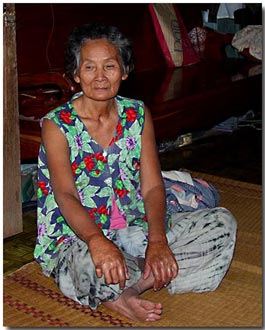
Sports – Sport images also tell stories. How much of the sport, it’s surroundings, its spectators, and whatever trappings are up to you as the photographer. How you arrange these factors in the frame to tell the story is the composition. Action
is popular, especially action that “wows” the viewers. Action shots can show motion, movement, skill and coordination. These are often the most treasured by the subjects during the later years of their life.
This sample was taken with film because at the time it was taken the Nikon F5 with “mods” which provided over 9 frames per second (almost twice as fast as the nearest digital camera of it’s day) and combined with an image
stabilized lense with a special mode from shooting from moving platforms (such as helicopters and boats) allowed me to capture tack sharp images from the back of a ski boat at 200mm’s. Keeping in mind that slide film provides NO latitude
in exposure correction, and that I was in the pull boat which was traveling in excess of 50 knots, this picture combines the elements of a sports picture while also combining the elements of a portrait allowing proper exposure, motion, showing
of speed, degree of difficulty, easily recognizable subject, look of concentration, and the special effect elements of the a frozen wall of water in the background and the mirrored reflection in the foreground. During this event I captured many
“sports” pictures, but only a handful that combined sports with portraiture elements. These are the type of shots that end up on the sports page IF the subject wins or does something notable. Gymnastics, baseball, football, and even
speed skating provide much easier subjects for starting out, even at their fastest speed it’s much easier shooting from the sidelines from a tripod, than when bouncing around inside of a speeding ski boat.
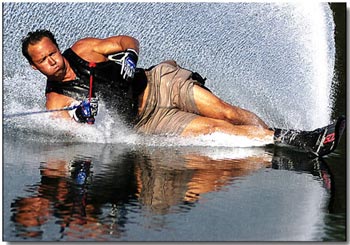
Formal Portraits – Lets talk or about conventional portraits because this is the type we’ve grown up noticing. Every year at school we posed for pictures and one day were sent home with a white envelope with a selection of portraits that basically
documented our appearance at a certain time and place of our life. In my opinion the best of these are glorified passport photos. We’re attaching an image to an official document that shows it’s viewer what we look like in a certain
way. These are easy. We place the person in the center of the frame against a suitable background, adjust the camera to face them head on, perhaps solicit a smile, and snap the frame. In a studio we’ll use lighting to compliment their skin
tones and build shadows under the chin and perhaps leave the far side of the face in a shadow as well to best define the shape of their face. We might show them smiling, in deep thought, or showing any desirable emotion.
We can work towards making a formal portrait resemble a painting. These are very popular. They’ll still be in the centre of the frame but not necessarily looking at the camera, perhaps off to the side where we can still see the beauty
of their eyes and the emotion they contain. If it’s a lady we’ll arrange the hair to fall down in an attractive manner and use lighting to produce a near 3D effect. In this type of portrait we want to present them to be studied and
observed in the same way as we would a passport photo, but obviously now in a different way. We want to highlight their features, beauty, skin, and eyes. We want to show this head shot in the most attractive way possible.
This is a pretty standard portrait taken and processed in a manner consistent with possible conversion to a “painterly” effect image for printing directly on canvas. In fact this is what she we did, but it’s next to impossible
to show this near 3D textured type of print on-line so I’m sharing the “step before.” This composition was shot in the studio against a chromakey green background, which was then digitally removed and another background added
which best complimented the subject. The background becomes an important part of the composition.
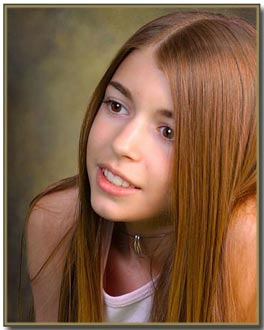
Sometimes we’ll show them sitting so more of their body shows, say from the mid-thigh to the top of their head. Often standing so we can see the shape of their body, clothes, or other features. We’ll arrange them in the frame to present
the most attractive view and then depending on the background we select we might set them off to one side or the other and let the view of the background become part of our compositional elements. Since we’re still in the studio we might
use painted canvases that have hand painted pictures of sports props like a hockey goal net, a baseball diamond, or a different type of background from palm trees, a starry sky, or just about anything you can think of. Old Hollywood movies like
Bonanza would build a set using these hand painted backgrounds and when used with live set such as a camp fire with real horses and trees we might not even notice the Sierra Nevada mountains in the background are nothing more than painted canvas
scenes. In the studio we’ll use props, basketballs, hockey sticks, toy cars, small wishing wells, couches for nudes, stairs, and even live animals. We’ll “build” a “composition” or you might have heard
it called a “set.” Sets can make people photography very easy but be sure to make sure the composition that looks good empty, also looks right when adding people.
This sample was captured with a six year old digital point and shoot that would now sell on ebay for under $50. Knotts Berry Farm has much experience in building sets for their guests to use and except for resizing the image this is straight
out of the camera, no exposure adjustments, no colour boosts, no nothing. Snoopy and the painted background with the artificial (actual artificial flowers) flowers was the set, boy and lady provided to complete the scene.
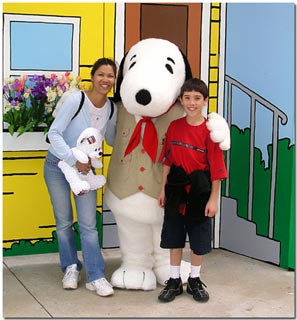
Moving outdoors we have many more choices than your average studio, all types of nature and natural and man made items. The wide stone steps of a courthouse, pillars at the entrance of the public library, a textured wood fence, trees, even signs that
document “we were here” at a certain time and place. These “background” elements add a great amount of not the majority of interest in such a portrait and care must be taken to only include that which we intend. For
instance we might have our fisherman from our last submission framed elegantly against the lake holding his string of fresh caught trout looking all the outdoorsman and at the moment we release the shutter a Coors Beer truck on it’s way
to make a delivery to the bait shop drives through the frame. This happens more times than you’d imagine, certainly more times than we notice until later when looking at the images when it’s too late to do anything about it.
Again, we build the composition and we choose what we’ll include. We could do a head shot of a pretty young girl up against the door frame of a Jeep, or back away to show her and the entire vehicle, or back away further still and show
her leaning against a jeep framed against scenic mountains with a beautiful sky. Much of what we choose will depend on the desired display size of the print. A headshot would effectively show her face for a 4×6 inch print, while a larger 8×10
would show her in an easy to view size next to the Jeep, while a 11×14 would show her effectively against the entire scene which includes the mountains. In all three examples she would be nearly the same physical size on the print, but the overall
size of the print would change along with what we include in the frame (composition).
This image was intended to become part of a popular type of senior portrait “flip book” containing many 4×6 inch images making it important to bring her face as large in the frame as practical. This is a flawed image in many
ways, but at it’s target size it pleased the client anyway. First, I accidently left the EV comp to +2, so it was overexposed by two stops. The beauty of shooting raw is that you can often save images that would have certainly been ruined
if captured in jpeg. Second, the hot spot on her hair is a serious flaw though it was unavoidable at the time. We also selected an aperture and focal length to produce bokeh in the background, it could have been blurred even further but it’s
much better than it would have been with the background in sharp focus.
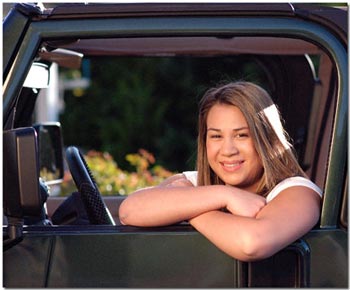
Bokeh is a word we hear much about these days. It’s a Japanese word used to describe the part of the frame which isn’t in focus, or the “defocused element” of the frame (composition). A quality lense properly used will render
a very pleasing and smooth bokeh area and effectively isolate the subject from an otherwise busy or distracting background by blending the colours and brightness of that background into a pleasing smooth blurred area.. This would obviously be
counter productive for a street photography scene where we’re using the background to tell a story, but ideal if the background was nothing more than a cluttered vacant lot with old rusted cars up on blocks killing the view. By using bokeh
as a compositional element we effectively enhance many portraits that would otherwise not be useful.
This is a good example of making use of bokeh has a compositional element. This image was captured under cloud cover so we’d have the nice soft light that only cloudy day can provide. By adjusting the white balance and exposure properly
we give beautiful and accurate skin tones and a well exposed image in what normally would have been a grayish dark area of the park, another advantage to using manual mode and making good use of features such as white balance. The problem was
that to use this angle we had to have a very unattractive background in the frame instead of the nice flowers if we’d turned 180 degrees. By introducing a heavy bokeh we blurred the background and isolated her from the background in the
process. Now the bare dirt, harsh night areas, and unattractive light pole have been blended into a pleasing blurred background consisting of a high grade bokeh only available from a high end portrait lense. With care we were able to start the
bokeh at the very far edge of her body towards the background.
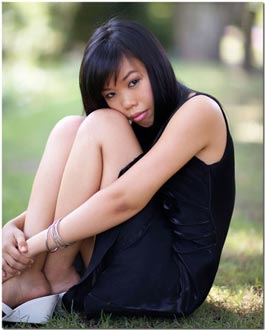
These are the basics of outdoor portraiture, but do realize there is so much more and there are really no limits other than your imagination.
Environmental Portraits – These are some of my favourite types of portraits. Nothing tells more about a person, nothing shows a person more in their more true form, and nothing tells a better story than capturing a portrait of the individual
in the environment which defines them. This isn’t a lot different than street photography in that the street is what they do and where they’re doing it. Imagine a middle aged bearded man with a set of carpenters overalls, a set of
safety glasses, and a satisfied smile on his face. This man is a master woodworker and his specialty is the lathe. Taking his picture outside his shop with is shop name in the background would be common, but what if we took his portrait standing
at his lathe while turning a dark wood bowl with a look of concentration on his face, wood chips flying, sawdust coating the hands holding the turning tool, and a pile of shavings obscuring his feet? A wonderful scene for sure. A larger print
might encourage you to back up a bit and include more of his workshop with the personal touches that define his work and character. Pictures on the way, the “I love Dad” coffee cup on the bench, a few half finished projects on the
table, and the early morning sunlight filtering through a paned window providing the illumination on the closest part of this face while allowing us to see the details of the lathe itself. These kinds of portraits aren’t hard to capture
though their rarity would make you think so. What’s rare is taking the time to get to know your subject and what’s important in their life, what means the most to them, and giving enough thought to the composition to build the scene
of his personality.
I couldn’t find my environmental portrait disks but I had these two which qualify handy and I’d like to talk about them. The first one is a good friend who is an avid photographer we met on a cruise to Alaska. He’s demonstrating
the proper technique for using a long lense and showing heavy concentration doing what he loves best. He’s one of these people who has never liked a single picture of himself so it become my mission to provide him with a portrait of himself
before the cruise ended. We were on the deck of the ship in the “Tracey Arm” area photographing glaciers and the wildlife in the area and I was watching how intently he was working. It was obvious he loved what he was doing and without
even thinking about it I picked up a body and lense not well suited for this type of thing and took a few frames. He loved this image! He now uses it in his signature block in several forums, in his office, business cards, anywhere he needs a
picture of himself. A well composed environmental portrait is attractive to most everybody who normally hates their picture. It shows their personality, their passion, their emotions, and the equipment they use every day. Notice he’s in
the right third of the frame? His equipment (camera/lense) extends across the other two thirds? That we have a near and far background with good contrasting colours? I think this works well.
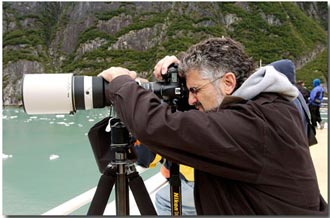
This second image of an environmental portrait is a group shot. A family building their own totem. This shot was taken in the 1800’s. What? Yes, this image was originally captures in 1878 and shows a family doing the very personal and meaningful
task of hand carving the family totem. Looks of concentration, tools of the trade, the project taking shape and the angle of view extends diagonally across all three intersections of the frame. When I first saw this image I immediately wished
for such an opportunity in my lifetime, indeed I’ll be looking. The next thing I did was pick up my own camera and hand held copied this photograph as it hung on the wall for all to view. And yes, I asked for and received permission from
the museum curator. She was actually amused I’d ask. To me it’s the perfect example of an environmental portrait and I wanted to share it with you.
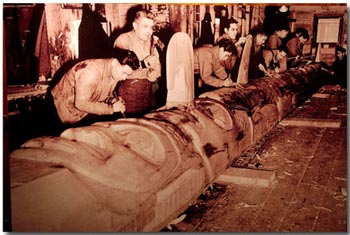
Imagine a rather round face intently leaning over a keyboard that used to be white but is now showing shades of dark brown from years of finger oil, the face lit by the illumination of the screen which is now reflecting back in the eyes which are so intently
watching the words form into a composition of their own. A nice portrait? Sure, but by now we know we can go further so lets back up some. Now we see it’s a middle age man wearing a latex purple bra with a lime green G-string and a hairy
back sitting on a stool formed from the cast of a blue dolphin with the nose appearing to disappear in.. Looking around the table we see a pyramid of empty Red Bull cans and a framed photograph of another middle aged man with a lean face, a crooked
smirk, and thinning hair. Perhaps his hero? His motivation for whatever he’s working on? We just don’t know. Backing up a bit more we can see the walls lined with knee high black boots, whips, leather masks, gag balls, and yellowed
photographs of ladies working chrome poles. There’s no carpet on the floor, only bare wood worn smooth over time with toe nail clippings scattered about and no waste basket in sight. Another step back and we can tell we’re in a basement
with no windows with the only lighting being a bare 25watt bulb hanging by it’s cord with a dirty piece of twine to turn it on and off. Over in the corner we see an old Army style cot with a crumpled drool stained yellowed pillow and under
the cot what looks like a months worth of dirty thongs and used cans of hairspray. At the foot of the cot we see a battered old suitcase with several baggage tags where we can make out the airport codes of BOS – BKK and these tags bring
the entire composition into a mental focus that is frightening in so many ways. Sometimes tight head shots are entirely appropriate!
Activities (weddings, graduations, parties, concerts, shows) – Activities that show people in the course of enjoying an event. Generally these types of photos should be composed in such a way to show both the person and the activity in the
best way possible. A wedding for instance has several key parts, the first is when the bride appears and is walked down the aisle and presented to the groom for the ceremony, then the ceremony itself, the first kiss, leaving the church/hall and
getting “riced” while making the way to the reception and of course the reception has it’s events. A good wedding photographer will make certain to be ready for these specific events during the wedding and will attempt to
capture the best composition showing the participants in the course of their events and the scenes around them at the time. Yes, they’ll zoom in a capture the emotion on the faces of the bride and groom while listening to the vows being
read, and then they’ll zoom out and show the alter, the priest, the couple, the best man, the brides maids, and as much of the “story” as is practical. Once again, composition is merely building the story of the event in the
frame of the camera. Many books on composing weddings have been written so it’s a bit optimistic to think I could cover the basics in just a single paragraph, but because it is a common and important photographic event I’m going
to use two sample images and draw a contrast between the two.
This first image ‘mostly’ isolates the bride and groom in a moment of happiness walking away from their outdoor alter area. In the far background we have the waterfall, part of the red bridge, and the green trees and foliage.
They are centered in the frame which might have been done better if they were more to one side, and in the near background we can see the group of bridesmaids watching them go. The foreground shows bubbles which they wanted used instead of rice
for environmental purposes. The couple is prominently placed in the frame and this image could stand alone on just the happy expressions on the couple themselves. Add the nice background, bridesmaids, and congratulatory bubbles and a composition
has been built that provides a series of memories on several levels, the beautiful location, bridesmaids, wedding couple, and bubbles. This works well, but in the next image my 12 year old son outdoes me once again.
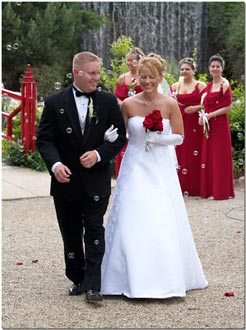
This second wedding image was captured by my then 12 year old son as he filled in for me when one of my assistants called in sick. For those of you who think this stuff is too difficult, you’re too old to learn, or the equipment is just too complicated,
keep this image in mind. He took three of this scene and I didn’t show the flawless one, but the one where he overexposed the scene and blew out her white dress. He knows this happens and bracketed his exposures (one up and one down) knowing
that was a faster to document the scene in a dynamic setting than stopping to check each exposure. Blowing out the dress is very common and often goes unnoticed, but it’s very easy to do which is why I thought I’d bring this up in
a composition submission. When a white dress is properly exposed often the rest of the frame is underexposed, but with three like bracketed frames we’ll make a perfect image out of the three. The composition he did a wonderful job with.
During the invocation when the heads were bowed in prayer he backed up just enough to include the ENTIRE wedding party in the composition. The couple, the ring bearer, flowergirl, best man, maid of honour, bridesmaids and groomsmen, and the priest.
We had talked about placement during the rehearsal and I’d even put white stickers on the concrete with the persons initials on the sticker so they’d know exactly where to stand for our composition. My son knowing this only had to
wait for the meaningful/emotional moments, frame the planned composition, and set the controls on the camera to capture a well exposed sharp image of the entire wedding party in a meaningful moment set against a wonderful background full of colour
and depth. The only think in my opinion that would have made this shot better was a different time of day so the sky would have been blue instead of washed out. They wanted this time of day and for the most part things came out well, but it could
have been better. Of course I could use Photoshop and put a blue sky in the frame but with this client accuracy was more important than the little stuff and I respect that. This scene could even be cropped on the top and bottom evenly to eliminate
the sky, many choices when you get things close to right.
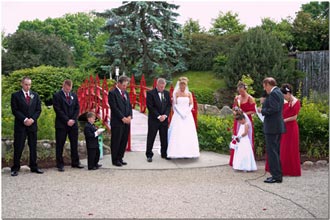
We could go on and on with examples of composing images which include people, but we must stop somewhere and I fear I’ve already overstayed my welcome. With just a bit of imagination you’ll never run out of great ideas and you’ll
never fail to make someone’s day when presenting them with such a photograph. In the next part of the composition series we’re going to concentrate on landscapes which can be very interesting and rewarding.
Until then..
Stickman's thoughts:
Another really excellent piece. Oustanding.



